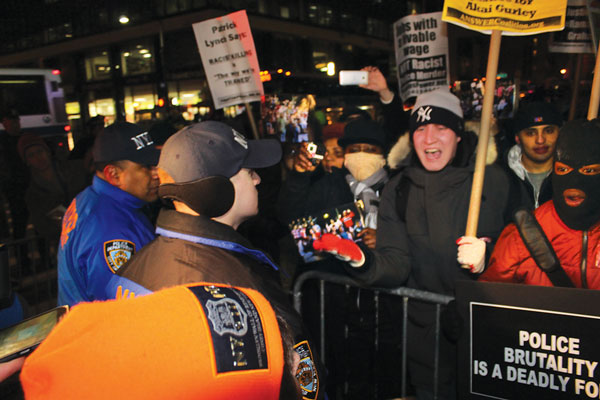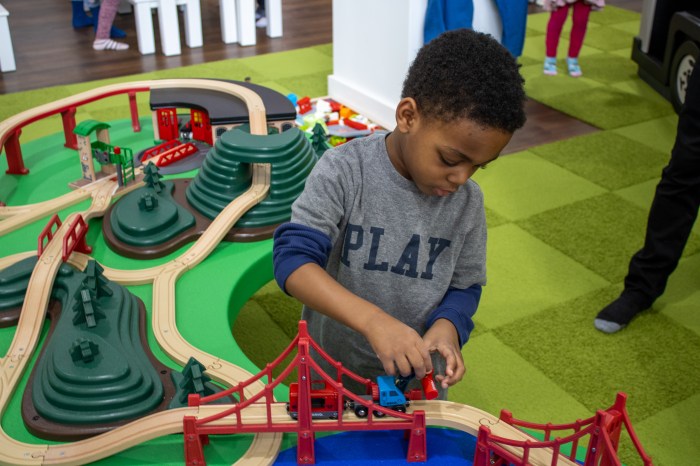
BY ZACH WILLIAMS | Dueling contingents of protesters demonstrated outside City Hall on Fri., Dec. 19, engaging each other in a heated battle of words the night before a lone gunman would fatally shoot two police officers in Brooklyn.
The verbal sparring began in the early evening hours, soon after about 100 people assembled for a #ThankYouNYPD rally, organized in response to the ongoing protests against police brutality, which have been dominating headlines for weeks. About 100 more people came to oppose this counter-protest and highlight their support for reforming New York Police Department practices.
Rhetoric would only grow more heated in the subsequent days following the fatal shooting of Officers Wenjian Liu and Rafael Ramos by Ismaaiyl Brinsley, a man who posted antipolice statements on social media, as well as references to Eric Garner, the Staten Island man who was killed during an arrest by a police officer on July 17.
At the dueling City Hall protests, police stoically manned the middle ground between the two groups, who were each confined to protest corrals — set up by police for the occasion — on the eastern sidewalk of Broadway near Murray St.
For several hours, the two sides rallied, spoke to the media and cast aspersions at the other side. Police supporters emphasized the rule of law and the dangers endured by law enforcement.
For some among that group, the death of Garner — an unarmed black man who died after a police officer choked him during an arrest — was not representative of the department, which they said has distinguished itself, particularly since 9/11.
“I think they did such a great job then and they do a good job now,” said Peggy Padovano, a Staten Island resident. “I think they are getting a really bad rap because of the incident that happened on Staten Island.”
The ongoing protests are “awful,” and target police officers for simply doing their job, said Carmen Rios, a Chelsea resident and wife of an N.Y.P.D. officer.
“Don’t even get me started about them,” she added of the protesters on the other side, who at that moment were chanting: “How do you spell racist? N.Y.P.D.”
Some activists protesting police brutality moved into the midst of N.Y.P.D. supporters to debate police practices, such as “Broken Windows,” a public-safety philosophy championed by Police Commissioner Bill Bratton that emphasizes enforcing laws against minor offenses to prevent violent crime.
“While we do respect police officers,” said Eleni Zimiles of Brooklyn, “we really feel that the Police Department needs to be held accountable for its work, and we need to have an accountable system, and we need to end the criminalization of black and brown bodies.”
Only one police officer has ever been convicted of a crime out of the 179 N.Y.P.D.-related deaths since 1999, according to the Daily News, which noted in a Dec. 8 article that 86 percent of the dead were Hispanic or black. Three police officers were indicted among the 179 incidents.
The next day, Brinsley killed the two officers in Bed-Stuy, after shooting his estranged girlfriend in Maryland earlier in the day.
The deaths followed months of escalating tensions between Mayor Bill de Blasio and the police.
“That blood on the hands starts on the steps of City Hall in the office of the mayor,” said Pat Lynch, head of the Patrolmen’s Benevolent Association, the police union. Former Governor George Pataki and former Mayor Rudy Giuliani also criticized de Blasio’s handling of recent protests.
De Blasio, for his part, urged protesters to adopt a moratorium on street demonstrations out of respect for the fallen officers.
But cop critics say they will continue their activism, though they reiterated they must do so through nonviolent means. In a statement signed by 20 activists groups, they accused Lynch and N.Y.P.D. leadership of appropriating the two officers’ deaths for political purposes.
Brinsley’s actions do not reflect the belief of the thousands of New Yorkers who have taken to the streets in recent weeks, according to the statement.
“This individual acted as a lone wolf and committed a heinous crime,” Pete Haviland-Eduah, national policy director for the Million Hoodies Movement for Justice, one of the 20 groups, said in a telephone interview.
He said the ongoing protests seek to develop a social consensus around how best to police local neighborhoods, but doing so will take time.
Even in the middle of the Dec. 19 demonstrations, activists from both sides of the issue could find common ground despite the angry arguments and obscene gestures made by people next to them outside City Hall.
A young black man from the Upper East Side and a white, middle-aged woman from Staten Island spoke at length about police relations with minority communities from respective sides of the protest corrals. They agreed that more needs to be done to ensure fairness in the judicial system, while also recognizing the contributions made by police to public safety over all.
“He heard me through all of the noise and we started to talk back and forth, and we were able to agree on certain things and find some common ground,” said Diane, a woman who came to support police and only gave her first name. “And I think that’s what people need to do not only in this city but around the country.”

















